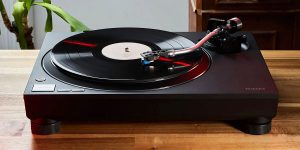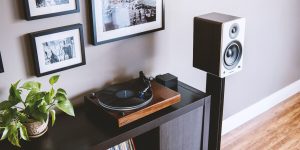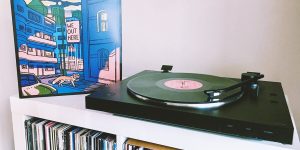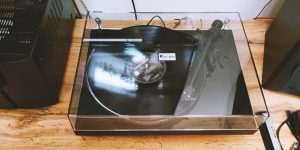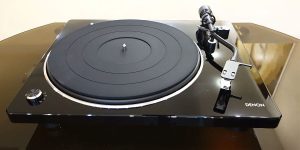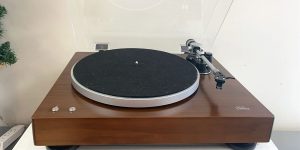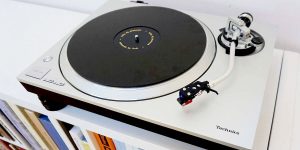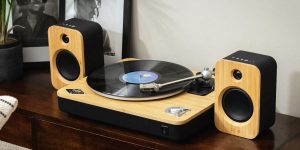A vinyl player cannot reproduce sound by simply extracting sound from the tracks of a record. You need a preamplifier that processes the outgoing signal and outputs it to the speakers to hear the music. For audiophiles, sound always takes an external phono stage, but for simple versions of analog sound at home, it is quite suitable for the built-in one.
In this article, I present a selection that will help you choose the best turntable with preamp. The selected models are representatives of premium, mid-range, and budget segments, so anyone reading this article can find a worthy turntable. You can find the built-in preamplifier’s features, advantages, and disadvantages at the end of the review.
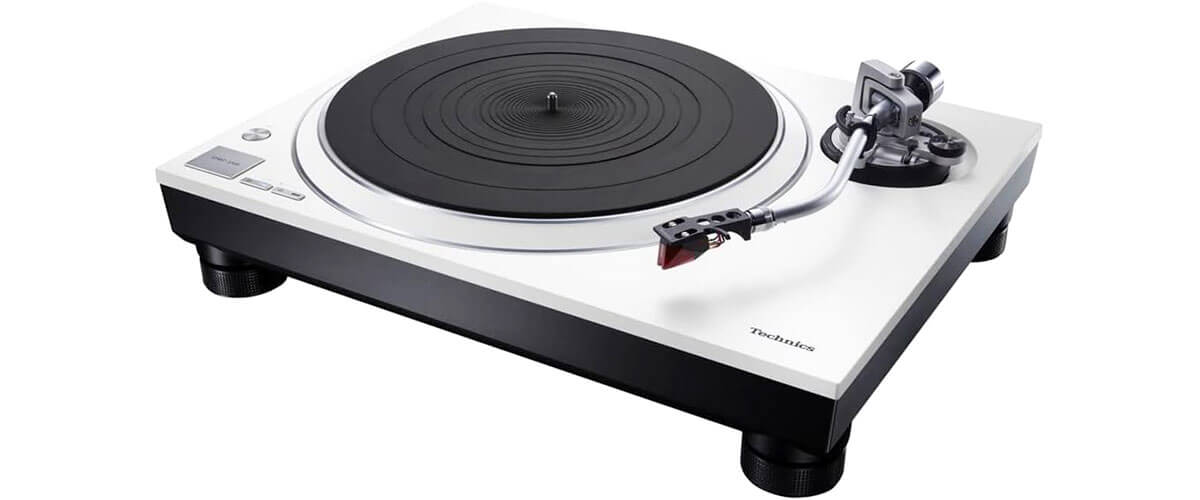
Turntables with preamp comparison table
| Name | Drive type | Operation type | Speeds | Phono Pre-Amp | Bluetooth | Review |
|---|---|---|---|---|---|---|
| Technics SL-1500C best overall | direct | manual | 33 1/3, 45, 78 RPM | yes | no | Review |
| Music Hall Classic also great | belt | semi-automatic | 33 1/3, 45 RPM | yes | no | Review |
| Fluance RT81 budget | belt | manual | 33 1/3, 45 RPM | yes | no | Review |
| Pro-Ject T1 Phono SB mid-priced option | belt | manual | 33 1/3, 45 RPM | yes | no | Review |
| 1byone H009 with built-in speakers | belt | manual | 33 1/3, 45 RPM | yes | yes | Review |
Best turntable with built-in preamp reviews
Technics SL-1500C – best overall
This Technics SL-1500C review features a premium model from the brand's lineup that combines classic traditions with modern improvements. The vinyl turntable has semi-automatic control, a direct-drive motor, and a built-in preamplifier for a more stable spin. It's representative of the mid-range segment, bordering on premium. But you won't need the extra investment unless you decide to improve the already excellent sound over time.Design
 The design is attractive and available in two colors (matte black and silver). But as I often say, weight is more important than looks. The SL-1500C turntable weighs 21.2 pounds. The diecast aluminum platter is also quite heavy at 4.5 pounds. Combined with the adjustable legs, this gives good anti-vibration stability. I even jumped next to the turntable, but the needle stayed in place. The coreless direct drive motor was borrowed from the SL-1200 and premium SL-1000R moguls, as it has proven to be excellent, showing a quiet, stable operation. It holds speed very well, and noise reduction is represented by springs and rubber.
Among the notable things I can mention is a highly sensitive S-shaped tonearm. This shape is considered optimal, as it helps the needle to get into the grooves clearly and, consequently, to capture the sound more clearly. Controls are push-button: start/stop and speed. In general, this turntable can be recommended even for an inexperienced user; it will have no problems, including its functionality.
The design is attractive and available in two colors (matte black and silver). But as I often say, weight is more important than looks. The SL-1500C turntable weighs 21.2 pounds. The diecast aluminum platter is also quite heavy at 4.5 pounds. Combined with the adjustable legs, this gives good anti-vibration stability. I even jumped next to the turntable, but the needle stayed in place. The coreless direct drive motor was borrowed from the SL-1200 and premium SL-1000R moguls, as it has proven to be excellent, showing a quiet, stable operation. It holds speed very well, and noise reduction is represented by springs and rubber.
Among the notable things I can mention is a highly sensitive S-shaped tonearm. This shape is considered optimal, as it helps the needle to get into the grooves clearly and, consequently, to capture the sound more clearly. Controls are push-button: start/stop and speed. In general, this turntable can be recommended even for an inexperienced user; it will have no problems, including its functionality.
Features
Since the record player is semi-automatic, this means tonearm autolifting. Another aspect is designed to serve the inexperienced user or just to make life easier for even the experienced. Simply, when the track ends and you're not near the turntable, the needle keeps moving across the record, scratching it. That said, you have to set the needle manually - a tribute to the tradition of vinyl. As for the needle itself, the pre-installed Ortofon 2MRed cartridge is very good. It is often chosen as a replacement for lower quality ones because it combines cool characteristics and acceptable prices. That said, on the Ortofon website, you can choose to replace it with an even cooler cartridge (up to $1000) if you want to or when this one wears out. Also, the tonearm setup was not a problem; I'm sure any user can handle it. The Technics SL-1500C has three spin speeds (33 1/3, 45, and 78 RPM). I like not having to select certain records for my collection. A torque of 1.8 kg・cm accelerates a record (33 1/3) in 0.7 seconds. It's a tribute to the direct drive that DJs love so much, but this model is intended for home use as it doesn't have the right controls.Sound
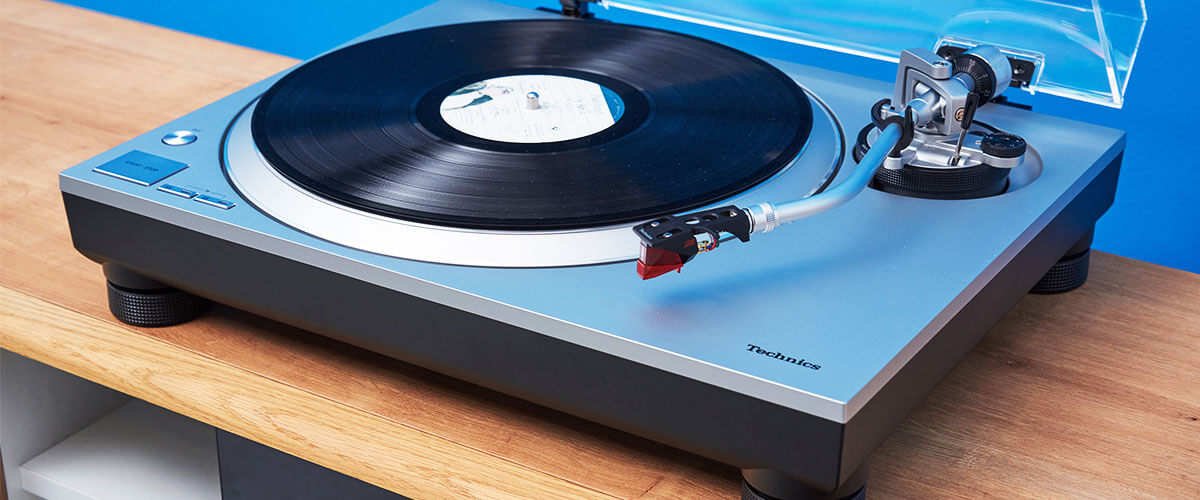 The Technics SL-1500C sounds great right out of the box. It keeps the sustain and speed of the record spinning for a very long time, and I didn't notice any slowdown in the middle of a track, as is often the case with cheap belt turntables.
I really liked the built-in phono stage (Wow And Flutter 0.025% W.R.M.S.), although I don't always recommend using an external one because even then, you'll get more out of it than with the built-in.
The soundstage is wide, with very rich bass and great midrange, and the treble doesn't ring out. The cartridge is very accurate; it doesn't lose detail during playback. When I connected an external preamp and replaced the cartridge with a more expensive one from Ortofon, I realized that too much difference for most listeners; such a replacement would not make a noticeable difference. But I could hear it, so I turned on my favorite Nevermind album and sang along to Kurt, enjoying the sound of SL-1500C.
The Technics SL-1500C sounds great right out of the box. It keeps the sustain and speed of the record spinning for a very long time, and I didn't notice any slowdown in the middle of a track, as is often the case with cheap belt turntables.
I really liked the built-in phono stage (Wow And Flutter 0.025% W.R.M.S.), although I don't always recommend using an external one because even then, you'll get more out of it than with the built-in.
The soundstage is wide, with very rich bass and great midrange, and the treble doesn't ring out. The cartridge is very accurate; it doesn't lose detail during playback. When I connected an external preamp and replaced the cartridge with a more expensive one from Ortofon, I realized that too much difference for most listeners; such a replacement would not make a noticeable difference. But I could hear it, so I turned on my favorite Nevermind album and sang along to Kurt, enjoying the sound of SL-1500C.
Key specs
- Drive type: direct.
- Operation type: semi-automatic.
- Speeds, RPM: 33 1/3, 45, 78.
- Phono Pre-Amp: yes.
- Speakers: no.
- Bluetooth: no.
- USB: no.
- Aux input: no.
Technics has been making music shades since 1960. Needless to say, how popular they are (present in the movie Mission: Impossible – Rogue Nation). The rather expensive Technics SL-1500C is representative of the premium class. It is a manual turntable with direct drive, three record rotation speeds, an S-shaped tonearm with Ortofon 2M Red cartridge, and a built-in high-end phono stage. In my opinion, the turntable is perfectly balanced, provides excellent dispersion, and sounds a head above the other models in my selection. This is the best turntable with a built-in preamp I could find so far.
Music Hall Classic – also great
The middle price segment is the most popular among users. After all, you can find vinyl turntable models here for every taste. In this Music Hall Classic review, I will tell you about a turntable from this category (up to $1000) with a built-in preamp and belt-drive motor, which will not require additional initial investments. Still, in the future, it can be upgraded, thus improving the overall sound. The company has been in the music equipment business since 1998, so they know a thing or two about detail.Design
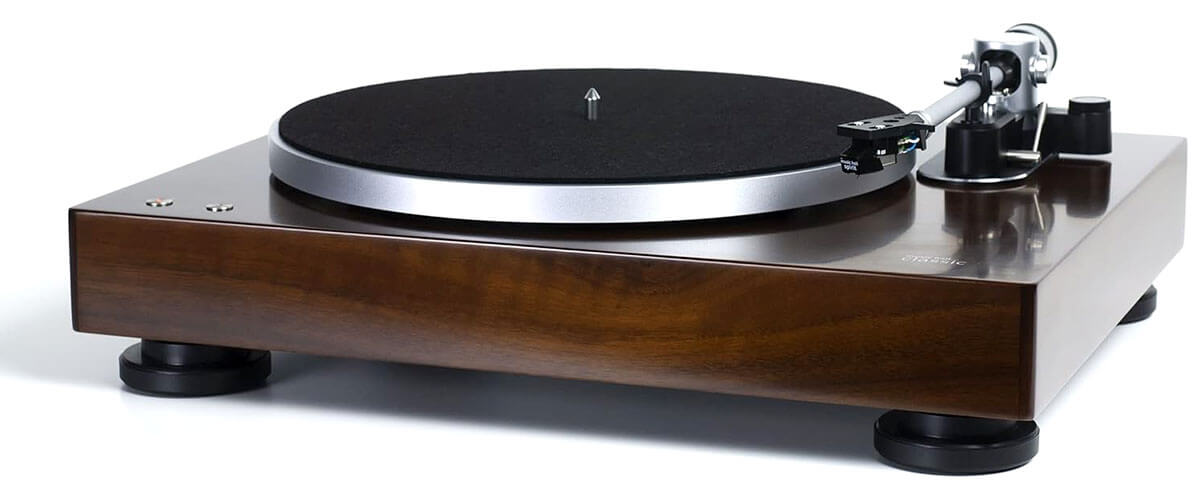 The chassis of this record player, made of MDF with a wood finish, looks very classic. It's like my father took his '60s record player out of the closet. I love this retro style; it gives my understanding of vinyl a charm. The weight of the plinth is pretty good at 15.2 pounds, and it handles external vibrations well. The feet are adjustable, thus leveling the Music Hall Classic even on a surface that is not too flat. Even the lid is made of good plastic (which is rare), and I don't feel like it could burst from awkward movement. Even the felt mat fits pretty well on the aluminum platter, but I still recommend the rubber one.
Only 2 power/33 and 45 buttons are on the top panel. This means you can turn on the turntable itself and switch speeds. However, since the buttons are mounted flush with the surface of the chassis, after a couple of days of testing, I realized that I pawed this place with my fingers.
The tonearm here is straight, which is typical for the middle segment. This shape is considered the simplest and not the most accurate. And it seemed rather flimsy to me. But I easily adjusted it parallel to the record and got a good playback without repeated adjustments.
The chassis of this record player, made of MDF with a wood finish, looks very classic. It's like my father took his '60s record player out of the closet. I love this retro style; it gives my understanding of vinyl a charm. The weight of the plinth is pretty good at 15.2 pounds, and it handles external vibrations well. The feet are adjustable, thus leveling the Music Hall Classic even on a surface that is not too flat. Even the lid is made of good plastic (which is rare), and I don't feel like it could burst from awkward movement. Even the felt mat fits pretty well on the aluminum platter, but I still recommend the rubber one.
Only 2 power/33 and 45 buttons are on the top panel. This means you can turn on the turntable itself and switch speeds. However, since the buttons are mounted flush with the surface of the chassis, after a couple of days of testing, I realized that I pawed this place with my fingers.
The tonearm here is straight, which is typical for the middle segment. This shape is considered the simplest and not the most accurate. And it seemed rather flimsy to me. But I easily adjusted it parallel to the record and got a good playback without repeated adjustments.
Features
The belt drive motor is indeed quite quiet, but the speed is not as stable as in more expensive turntables. According to the company's statement, some fluctuations in work speed are within the acceptable limits of the middle segment. I am not inclined to disagree with the brand's representatives because the Music Hall turntable showed good performance among many similar models. And the nuances will not be heard by most users. Anyway, belt drive is a classic option for damping vibrations when it comes to analog sound. As for the functionality of the vinyl turntable in question, it is semi-automatic. There is no auto-return function here; the tonearm simply lifts after the record is finished. But this is a good feature for inexperienced users who do not know how to follow the work of the needle. If you are a fan of falling asleep to music, this function is very useful because the turntable turns off when the record is finished (the record stops spinning). Music Hall Classic has only 2 rotation speeds (33 1/3 and 45), but this is normal for the middle segment. And since the company manufactures turntable accessories, the built-in cartridge is also from Music Hall. It can be replaced when it breaks. I easily installed Ortofon on it, but the selection is limited to carts under $100. So I couldn't improve the sound too much in this area.Sound
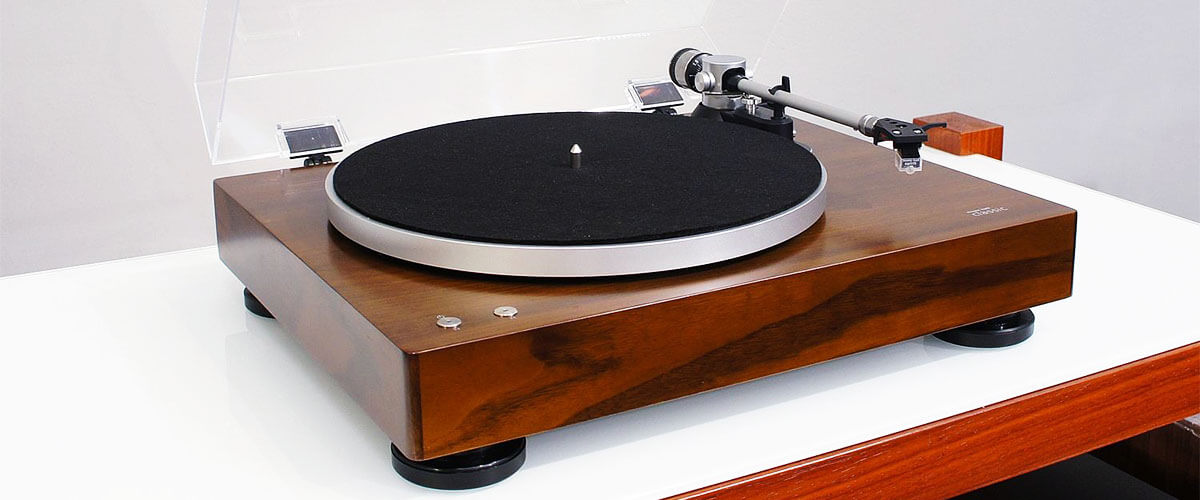 The Music Hall Classic produces a fairly clean, stable sound with the built-in phono stage. I really liked how it retained its warmth, dynamics, and brightness with David Miles' Miles in the Sky. The trumpet sounds confident, and the orchestra in the background, although muted, you can hear each instrument clearly. Not many players can cope with jazz, losing details. In this case, even with shelf speakers, the sound was rich.
No, of course, it does not mean that we found something in the middle segment that can overwhelm the sound of premium turntables. Even the external preamplifier reveals a wider range of colors in our model. But I would set Music Hall apart from the competition.
The Music Hall Classic produces a fairly clean, stable sound with the built-in phono stage. I really liked how it retained its warmth, dynamics, and brightness with David Miles' Miles in the Sky. The trumpet sounds confident, and the orchestra in the background, although muted, you can hear each instrument clearly. Not many players can cope with jazz, losing details. In this case, even with shelf speakers, the sound was rich.
No, of course, it does not mean that we found something in the middle segment that can overwhelm the sound of premium turntables. Even the external preamplifier reveals a wider range of colors in our model. But I would set Music Hall apart from the competition.
Key specs
- Drive type: belt.
- Operation type: semi-automatic.
- Speeds, RPM: 33 1/3, 45.
- Phono Pre-Amp: yes.
- Speakers: no.
- Bluetooth: no.
- USB: no.
- Aux input: no.
This 2-speed semi-automatic turntable with a DC motor will be a great alternative for those who want to save money. After all, it costs almost half as much as the Technics SL-1500C. But with it, you get only 2 speeds of platter rotation and a Music Hall Spirit cartridge, which, to my ear, is inferior a bit to Orthofon. Still, the turntable provides remarkable anti-resonance (heavy wooden chassis), and the automatic tonearm lift will keep your record from damage, especially if you are an inexperienced user. Music Hall Classic turntable with phono preamp produces clean, stable sound and handles most genres while maintaining the dynamics and brightness intended by the author.
Fluance RT81 – budget
The popular Fluance line offers five turntables that differ from each other according to the number in the name. And in this Fluance RT81 review, I'll tell you about the entry-level model of the series. The semi-automatic record player of the plug-and-play configuration can offer you decent quality for a small price, so it will be interesting. Let's begin.
Design
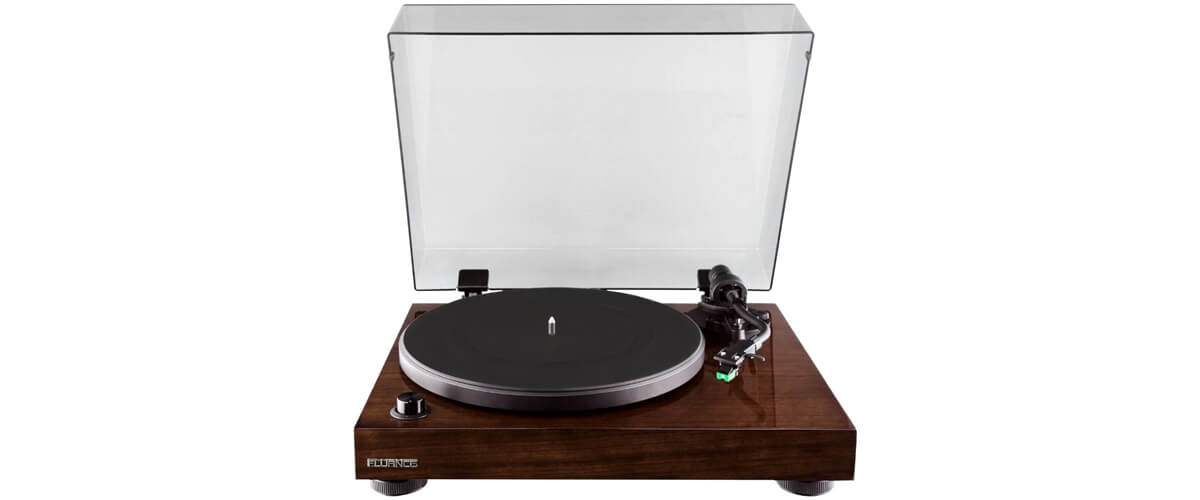
Externally, all turntables in the line resemble twins. The classic, or even retro, MDF plinth measures 5.5 x 16.5 x 13.75 inches and weighs 14.1 pounds, suggesting excellent stability and resistance to external and internal vibration. That's a great value for this price rank. Usually, inexpensive turntables are light and unstable, which requires additional weighting.
As for the other parts, they are also very good for the record player's price. For example, a heavy platter with a rubberized mat and an aluminum tonearm will last a long time. In addition, the S-shaped shape of the tone arm provides more precise hitting and sliding in the record's grooves than a straight one, which I would put in the advantages of the RT81 turntable. And the deck controls are simple and convenient. One single knob on the case changes speeds and turns off the vinyl turntable.
You'll find a dust cover included, which is easy to install. And I would also add that the turntable case is available in three glossy colors: Black, White, and Wood. I like it both externally and to the touch. It looks stylish and reliable.
Features

Speaking about the technical characteristics, it is worth noting that the RT81 has a built-in preamplifier. It's great from the point of view that when you take the device out of the box, you can immediately start using it. And also, if a budget was your priority when choosing a turntable, having a built-in phono stage will save you an additional investment. Of course, you will find a switch on the back panel that allows you to connect and use a better external preamp. Another thing worth mentioning here is that the RT81 has two record speeds of 33 1/3 and 45 RPM.
The wonderful tonearm I've already described comes with an Audio Technica AT95E cartridge pre-installed. And even though it doesn't initially offer you high quality for years, the upside is that it can be replaced. I should also note the presence of an auto-stop option, which stops the plate and raises the lever but does not put it back in place.
The deck has gold-plated RCA line outputs, which have a very good effect on the tone, giving it some warmth and softness.
As for the disadvantages, I would mention the poor quality grounding. As a result, you can hear a slight hum when operating, though not very loud. Of course, this disadvantage is insignificant for a turntable of this rank. In addition, you can do some manipulations with the grounding, thus reducing the unpleasant sound. And I have nothing else to "scold" the Fluance RT81 for. For its category, it offers excellent performance.
Sound
Let's not forget that the Fluance RT81 is a very inexpensive turntable. And as you may have noticed, the main parts that directly influence the sound quality are not the good ones. So it doesn't initially offer you audiophile sound. But to be fair, I have to say that it is very good. There are no blatant omissions, tinkling, or loud extraneous noise, as in many budget models. The sound is smooth and warm but not detailed enough. Nevertheless, by installing an external preamplifier and replacing the cartridge with a high-quality one, you can get a cool record player that will please you with its chic style for many years.
Key specs
- Drive type: belt.
- Operation type: manual.
- Speeds, RPM: 33 1/3, 45.
- Phono Pre-Amp: yes.
- Speakers: no.
- Bluetooth: no.
- USB: no.
- AUX: no.
Fluance’s RT lineup has won fans worldwide for offering inexpensive turntables of very good quality. You get a fairly stable MDF construction with rubber feet that reduce vibrations, 2 record rotation speeds, and a built-in Audio-Technica AT95E cartridge that is easy to find on the market and simple to replace. The S-shaped tonearm (like the review leader Technics SL-1500C) does an excellent job extracting sound. The warm and wide musical picture sets the Fluance RT81 apart from other budget turntables. Still, it sounds much simpler than the models presented in the rating.
Pro-Ject T1 Phono SB – mid-priced option
The mid-price segment of turntables offers a very wide range of choices. Unfortunately, it is very easy to get confused or make the wrong choice in such an abundance of models. So you should pay attention to the details that can distinguish a particular device, putting it at a level worthy of your attention. In this Pro-Ject T1 Phono SB review, I will tell you about a record player of good build quality, sound, and straightforward operation, as well as a detailed examination of its features.
Design

The lightweight and portable Pro-Ject T1 weighs only 8.4 pounds and measures 415x100x335 mm without a single plastic part. The medium-density, cavity-free fiberboard deck is available in three colors: Gloss Black, Satin White, and Walnut Veneer, so you can choose to match your interior. Its very discreet, elegant design is not overloaded with anything. The only On/Off switch is on the bottom left - you don't have to look for it. It's very handy.
Although the manufacturer compensated for the lightness of the turntable with a heavy 8mm abrasive glass plate with a felt mat, and it is quite capable of handling vibration problems, unfortunately, the feet are not adjustable, so you better set the turntable on an as flat surface as possible.
The 8.6" straight aluminum tonearm is also very lightweight but sturdy and will last a long time. The overall visual impression of the deck is very nice and doesn't look cheap. It comes with a dust cover, and a high-quality Connect it E RCA Phono cable.
Features

The Phono SB is an upgraded version of the T1, so it has some bonuses. Such as the Precision Belt Drive with precisely adjustable speed stability and 33/45 RPM electronic speed changeover.
The deck also has a built-in preamp, so you don't have to splurge to buy one. But thanks to the RCA Phono/Line output switch, you can always connect an external preamp to enhance your audio system.
The tonearm has a very good built-in Ortofon OM5e moving-magnet cartridge. It is pretty expensive separately, but it's qualitative and durable, so you don't have to worry about replacing it in years to come. In general, the tonearm's design inspires confidence with its anti-resonance action, thanks to the low-friction bearing of the tonearm and the absence of vibrations. The Wow and Flutter provide a range of 0.23% - 0.25%. Considering the price and the handmade European assembly, this is great functionality!
Sound
The T1 Phono SB turntable produces a very warm, enveloping sound. It won't probably satisfy the sophisticated audiophile's needs because its bass is not the cleanest and most detailed, but it is quite compensated by the low and midrange frequencies. The upper frequencies are also quite good, without any outright flaws, creating an overall pleasant picture. I did not hear any outright shortcomings, noise, or blurring, which means that T1 Phono SB copes with its task, suppressing noise and vibrations. And taking into account its elegant appearance, functionality, and ease of setup - I would conclude that it is worth its money.
Key specs
- Drive type: belt.
- Operation type: manual.
- Speeds, RPM: 33 1/3, 45.
- Phono Pre-Amp: yes.
- Speakers: no.
- Bluetooth: no.
- USB: no.
- AUX: no.
The winner in the category of best turntables with preamp in the middle segment is the Pro-Ject T1 Phono SB. The beautiful narrow case is aesthetically pleasing and will suit many people, the glass platter is optimal for records (keeps balance well), and the built-in OM5e cartridge. However, one of the simplest Ortofon lines is still professional and can be replaced by a more expensive OM series cartridge.
The sound is good and stable, but still, the built-in preamp does not reveal the full potential of the turntable; with the use of an external one, the picture becomes more saturated. Still, the initial package will satisfy the unsophisticated user. Control is fully manual, which speaks of the professional approach of the manufacturer and will help teach you how to handle the equipment and platins.
1byone H009 – with built-in speakers
In this 1byone H009 review, I want to tell you about a nice retro-style all-in-one record player. The turntable is inexpensive but has features that many people might like. It's more of an out-of-the-box audio system, so you also get rid of the extra spending and hookups. Let's go!
Design
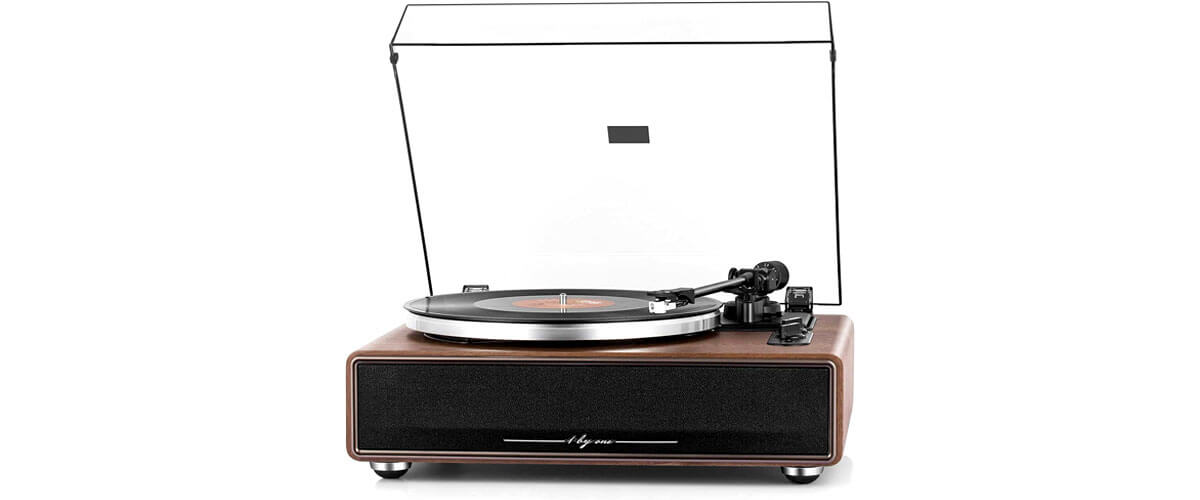
Well, the turntable's plinth is made of wood and metal in a streamlined shape with rounded corners. It is very transportable as it weighs only 13,3 pounds and measures 14.57x17.32x7.56 inches. The H009's natural wood veneer finish is pleasant to the touch, and its retro-style design is eye-catching.
On the front of the case, there is a speaker with a sleek 1byone logo. The control buttons are located on the top panel and are a playback speed switch, a switch to Bluetooth, and a start button, which must be pressed and held for the system to turn on.
A 30 cm diameter Aluminum die-cast platter that weighs about 1.2 pounds, a slip mat, a dust cover, and an instruction manual are included.
Features
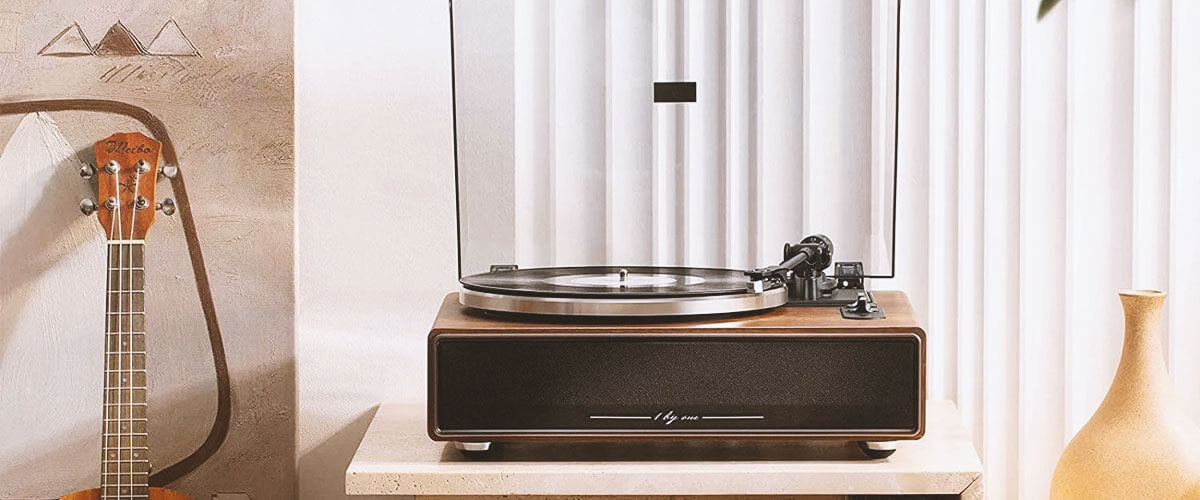
1byone is an all-in-one audio system that includes a turntable, receiver, and speakers. The manual belt-driven control ensures that records rotate at 33-1/3 and 45 RPM and dampens vibration well. Stable operation is ensured by a DC motor and an anti-skating function.
The 8.6" long static balanced straight tonearm has a very good Audio-Technica Moving Magnet AT3600L cartridge with a diamond tip stylus. It glides precisely over the groove and extracts a clear, crisp sound.
The H009 has a built-in switchable phono preamp that will allow you to connect external powered speakers. The proprietary speaker has four speakers, and you can not only listen to vinyl records with it, but you can pair and play music from any device, be it an iPhone and Android smartphone, tablet, PC, the USB-mp3 player through the player speakers using Bluetooth as well as through the Aux-in port.
Sound
Regarding the sound, I think that for its price, the turntable sounds pretty good. I would even say it is more a speaker with a vinyl playback function than the other way around. However, that doesn't make the 1byone a bad record player. In principle, it does its job. The manufacturer has saved money on materials, but the technical parts are of quite good quality. For example, the cartridge really does half the job when extracting sound. Thus, I can conclude that the sound is stable and clear, with no obvious flaws. If you are not a professional musician and don't want to bother with connections, settings, and so on - this H009 may satisfy your desires well.
Key specs
- Drive type: belt.
- Operation type: manual.
- Speeds, RPM: 33 1/3, 45.
- Phono Pre-Amp: yes.
- Speakers: yes.
- Speakers power, W: 36.
- Bluetooth: yes.
- USB: yes.
- AUX: yes.
A player with built-in speakers should have been on my list as an additional representative of the budget category, which requires even less investment from you at the initial stage. Of course, audiophiles will disagree because even a built-in preamplifier for a turntable is considered an oxymoron; what to speak about the combination of “all-in-one”? But that’s not what’s important to you and me.
Given that the 1byone H009 has a receiving Bluetooth, the model should be considered more like a wireless speaker with a disk and tonearm attached to it. I’m not a fan of the genre, but I know how popular this turntable is with users. The design is unreliable, but from the point of view of “toy” and entertainment, it will do quite well. The manufacturer even installed a removable Audio-Technica AT3600L cartridge, making the model stand out among cheap turntables for the better. And as a result, the H009 sounds quite good. But I’m not sure it will last long.
Why choose a turntable with a built-in preamp?
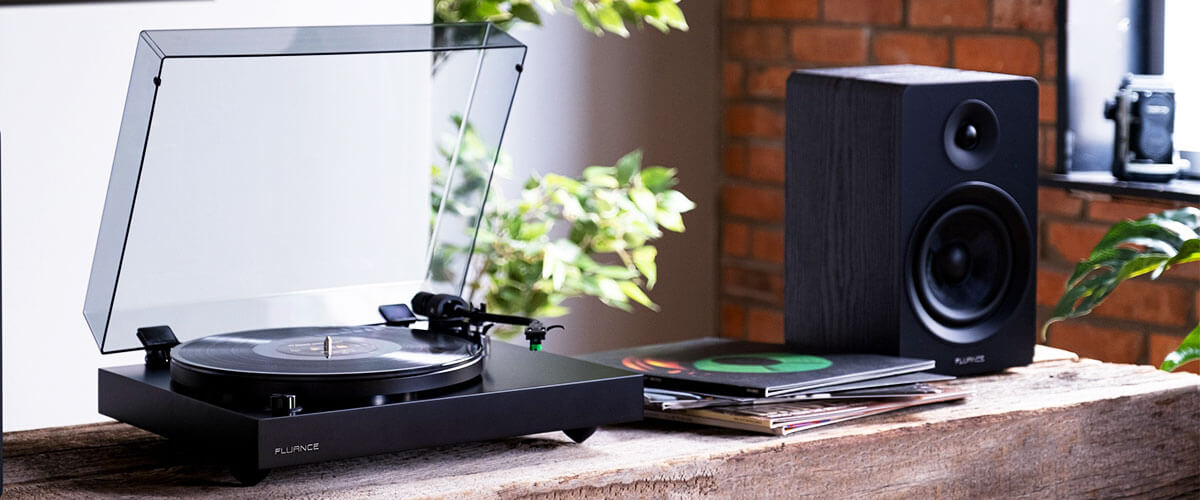
Simplifying your vinyl setup
When you choose a turntable with a built-in phono stage, it saves you space and installation time. What do I mean by that? An external preamplifier is a separate device connected to your vinyl turntable and speakers with separate cables. Plus, it takes up space on its own. That is, this kind of turntable will be convenient for those with a small room or limited space for installing an audio system (often involving other components). Less space, less cables, less dust, less fuss. Is that enough of an argument?
However, I will remind you that a built-in phono stage will never sound as good as an external one.
Ease of use for beginners
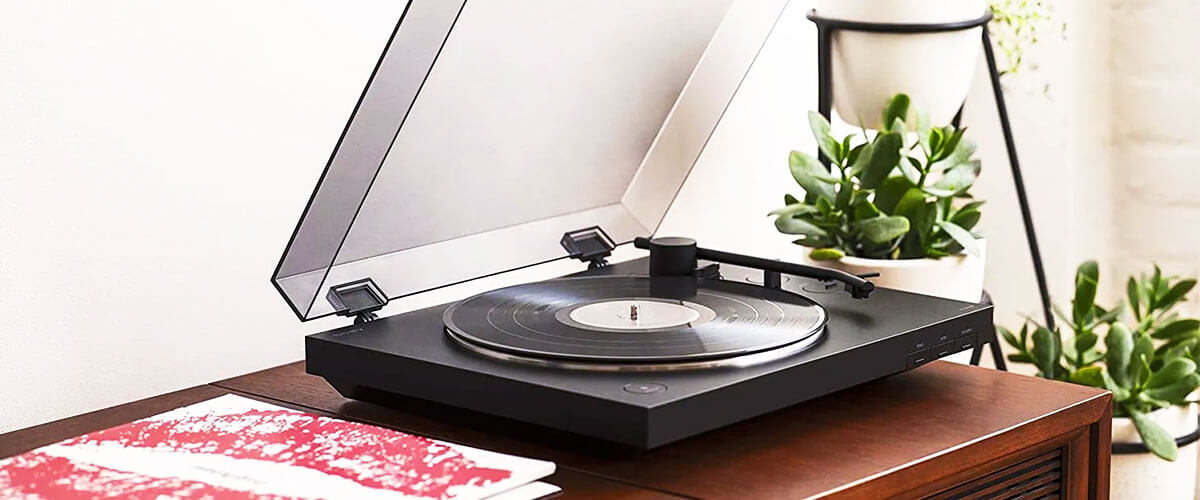
It’s simple. You get an all-in-one and Plug-and-Play device. You take it out of the box, plug in your speakers, turn on the power, and you’re ready to listen. Usually, these turntables are well-tuned right out of the box. With higher quality, more expensive vinyl turntables, you’ll have to mess around, assembling and tuning all the system components individually. That’s why it’s generally considered that such turntables are well-suited for beginners.
Affordable solutions
Choosing a turntable with a built-in preamplifier atomically means that you agree to an average level of signal processing and, as a result, an average level of sound. It will be clean and pleasant enough (but true audiophiles will not appreciate this level). It also means you won’t need to upgrade your system for long. Complex systems with many components need to be upgraded constantly.
Naturally, this entails lower costs. Initially, you don’t need to buy a separate phono stage, which means it’s good for those not on a budget.
We are supported by our audience. When you purchase through links on our site, we may earn an affiliate commission at no extra cost to you.
Our newsletter
* We will never send you spam or share your email with third parties


